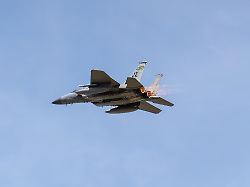“A resounding success”
NATO faces “steep learning curve” on “Air Defender”
06/23/2023, 11:58 am
1,800 of the 2,000 planned flights are carried out: For Lieutenant General Ingo Gerhartz, the major maneuver “Air Defender 23” is “a complete success”. Even civil air traffic is only disrupted “in a few minutes”. Praise comes from politicians – and calls for a sequel.
After the “Air Defender 2023” maneuver, the Air Force Inspector, Ingo Gerhartz, emphasized the importance of the military infrastructure in Germany for NATO. At the Schleswig-Jagel air base, the lieutenant general spoke out against closing other military airports. Due to its geostrategic, geographic and geopolitical situation, Germany must see itself as a hub and be able to absorb NATO forces. The same applies to land forces.
The military alternate airfields Hohn in Schleswig-Holstein and Lechfeld in Bavaria were used in Germany to accommodate the US aircraft flown in for the maneuver across the Atlantic. “And that showed us all again: We must not give up these two airfields. We have to keep these two airfields, both Hohn and Lechfeld,” said Gerhartz.
“Absolutely smooth”.
According to the Bundeswehr, the maneuver hardly caused any disruption to civil air traffic. The ten-day exercise involving 250 aircraft from 25 countries went “absolutely smoothly,” said Gerhartz. Thanks to the good planning of German air traffic control, there were “no flight cancellations” in civil air traffic and delays there were only “a few minutes”.
Overall, the maneuver was “a complete success,” said Gerhartz at the Jagel Air Force Base in Schleswig-Holstein. It has proven that the allies are able to move large amounts of military material within a few days and can then hold out for a two-week large-scale exercise. Germany received a lot of praise from the allies for organizing the maneuver.
Of the 2,000 planned flights, 1,800 actually took place, said the air force inspector. One day the machines stayed on the ground because of thunderstorms to be on the safe side. “A fulfillment of 90 percent is still a top value for such large-scale exercises,” said Gerhartz. In the first case, the machines would of course also fly during thunderstorms.
An important goal of the exercise was to combine the machines and systems of different air forces in a data network, said Gerhartz. This was not successful “on the first day”, but then it worked. There was also a “steep learning curve” in other areas of cooperation during the exercise.
Praise from traffic lights and opposition
The CDU defense politician Henning Otte praised Germany’s organization of the major maneuver “Air Defender 23” with NATO allies. “Germany has taken on a leadership role and has shown that Germany can lead,” said CDU politician Henning Otte on Deutschlandfunk. This is also seen in the participating countries. The signals from there are “very good”.
The maneuver is “a sign of cohesion and strength,” said Otte, who is the Union faction’s defense policy spokesman. It made it clear that “this exercise worked even under the threat of Russia.” This underscored the character of NATO as a “defence alliance with a deterrent effect”.
The chairwoman of the Defense Committee in the Bundestag, Marie-Agnes Strack-Zimmermann, also described the large-scale maneuver as exemplary for the future of NATO. The FDP politician called for further joint exercises to practice how to defend one’s own territory against possible attacks by Russia or other aggressors on Friday in Berlin. The role that Germany played as the initiator of the maneuver was felt to be extremely positive by all partners.
“Germany has led in accordance with its geographical location and its economic power and has shown that it has capabilities that its partners can also fall back on,” Strack-Zimmermann continued. “This should also affect all other branches of the armed forces in the future. We have finally arrived in reality.”
